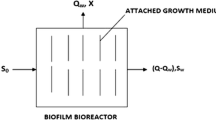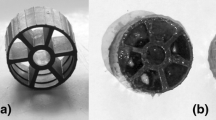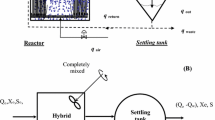Abstract
A biofilm model with substrate inhibition is proposed for the activated sludge growing discs of rotating biological contactor (RBC); this model is different from the steady-state biofilm model based on the Monod assumption. Both deep and shallow types of biofilms are examined and discussed. The biofilm models based on both Monod and substrate inhibition (Haldane) assumptions are compared. In addition, the relationships between substrate utilization rate, biofilm thickness, and liquid phase substrate concentration are discussed. The influence order of the factors that affect the biofilm thickness is studied and discussed by combining the Taguchi method and grey relational analysis. In this work, a Taguchi orthogonal table is used to construct the series that is needed for grey relational analysis to determine the influence priority of the four parameters S B , kX f , K s, and K i .







Similar content being viewed by others
References
Benefield LD, Randall CW (1980) Biological process design for wastewater treatment, Prentice Hall, New York
Tokuz RY (1989) Biodegradation and removal of phenols in rotating biological contactors. Water Sci Technol 21:1751–1754
Opatken EJ, Bond JJ (1991) RBC nitrification of high ammonia leachates. Environ Prog 10:60–63
Buisman CJ, Wit B, Lettinga G (1990) Biotechnological sulphide removal in three polyurethane carrier reactors: stirred reactor, biorotor reactor and upflow reactor. Water Res 24:245–251
Brower JB, Barford CC (1997) Biological fixed-film systems. Water Environment Res 69:487–500
Clark JH, Moseng EM, Asano T (1978) Performance of a rotating biological contractor under varying wastewater flow. J Water Poll Control Fed 50:896–911
Rittmann BE, McCarty PL (1980) Model of steady-state biofilm kinetics. Biotechnol Bioeng 22:2343–2357
Suidan MT, Wang YT (1985) Unified analysis of biofilm kinetics. J Environ Eng 111:634–646
Suidan MT (1986) Performance of deep biofilm reactor. J Environ Eng 112:78–93
Arquiaga MC, Canter LW, Robertson JM (1995) Microbiological characterization of the biological treatment of aircraft paint stripping wastewater. Environ Pollut 89:189–195
Sagy M, Kott Y (1990) Efficiency of rotating biological contractor in removing pathogenic bacteria from domestic sewage. Water Res 24:1125–1128
Go JS, Cho YH (1999) Experimental evaluation of anodic boding process based on the Taguchi analysis of interfacial fracture toughness. Sensors Actuators A 73:52–57
Georgilakis P, Hatziargyriou N, Paparigas D, Elefsiniotis S (2001) Effective use of magnetic materials in transformer manufacturing. J Mater Process Technol 108:209–212
Deng J (1982) Control problems of grey systems. Syst Control Lett 5:288–294
Deng J (1989) Introduction to grey system theory. J Grey Syst 1:1–24
Author information
Authors and Affiliations
Corresponding author
Rights and permissions
About this article
Cite this article
Chen, M.Y., Syu, M.J. Film analysis of activated sludge microbial discs by the Taguchi method and grey relational analysis. Bioprocess Biosyst Eng 26, 83–92 (2003). https://doi.org/10.1007/s00449-003-0340-2
Received:
Accepted:
Published:
Issue Date:
DOI: https://doi.org/10.1007/s00449-003-0340-2




